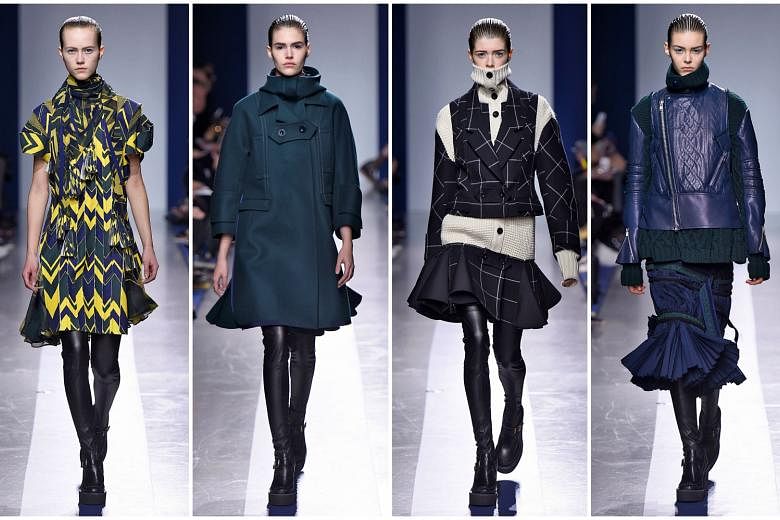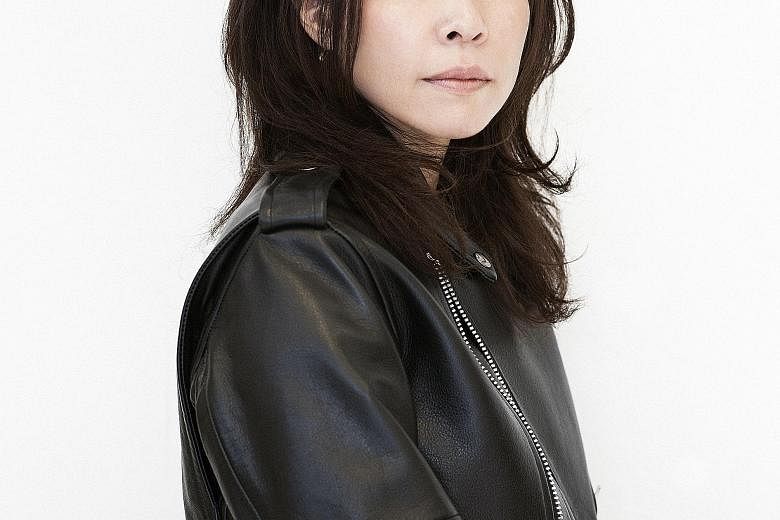In April, industry trade journal Women's Wear Daily christened six fashion labels the powerhouse brands of tomorrow. Among them, unsurprisingly, were major luminaries such as Alexander Wang, Proenza Schouler and The Row.
Perhaps the least known label in the cast of serious contenders was Japanese brand Sacai.
Compared with the others on the list, which also included J.W. Anderson and Christopher Kane, Sacai may be the farthest from being a household name. But in the fashion industry, the brand is known as a cult favourite, counting even Chanel designer Karl Lagerfeld as a fan.
"I was very honoured. It's very powerful and encouraging to have the attention and support of designers and others in the industry," says Sacai designer Chitose Abe in Japanese in a phone interview with Life.
"That being said, it isn't just about winning over the industry," adds the Tokyo-based 49-year-old. "Clothes are meant to be worn - they're not things to just hang up and decorate with - so the customers who wear them are important as well."
Deconstruction and hybrid design are signatures of Sacai, whose name is a play on the designer's maiden name Sakai. Ms Abe, who is married to fellow fashion designer Junichi Abe and has a teenage daughter, takes different materials such as knitwear, lace, and cotton and fuses them together in a single garment.
Often, the pieces look different from the front compared with the back and feature unexpected elements. Yet the brand's appeal lies in the fact that throughout the process, the designer manages to keep the looks feminine and flattering.
For the most recent fall/winter 2015 collection, which she debuted at Paris Fashion Week in March, it was all about playing with forms and silhouettes, says the designer. A masculine coat, for example, was transformed by dropping the waistline and changing the armholes, and splicing the fabrics with knit elements.
Almost all the fabrics, except for some lace from France, are made in Japan, where, says the designer, there are good fabric makers willing to try the ideas she suggests.
The brand, as well as its diffusion line Sacai Luck and menswear line, is available online at outlets such as Net-A-Porter and Club 21 Online. Prices range from about US$140 (S$190) for a simple T-shirt to US$1,900 for a multi-textured dress. The majority of items clock in at the mid- to high- three figures.
Sacai was not always defined by the mixing of materials and shapes, however. Ms Abe says that initially, when the brand started in 1999, she was simply creating things she wanted to wear. It took a few seasons to settle into her now recognisable look.
"The idea came about as I pieced together normal items to make something unusual," she says. "By putting them together they became like new versions of classics. Now I think it's become something only Sacai can make."
The brand has taken off in recent years, releasing a book Sacai: A To Z in March, expanding on the label's philosophy and setting up its first overseas stand-alone stores in Hong Kong in January and in Beijing in April.
The label is also carried at more than 175 multi-label stores worldwide, including London's Selfridges and Barneys New York.
Sacai opened an office in New York last October to handle the wholsesale business there and the designer has started talks with South Korean department operator Shinsegae Corporation.
"It's not like we have a specific strategy - it's more of a gut feel and whether it's the right decision for Sacai," says the designer, on why she decided to open those stores in China. "In all these years, my gut instinct hasn't failed me yet."
Sacai has also participated in some buzzy collaborations, teaming up with brands such as Birkenstock and Nike - she works with labels she loves, says Ms Abe - to create limited-edition goods with the famous Sacai texture mixing twist.
These new stores, tie-ups and offerings mark a faster pace for the brand, which has taken a slow and steady route to arrive at where it is today. The business has actually been around for almost two decades and the soft-spoken Ms Abe - despite looking much younger than she is - turns 50 in November.
The private company, which is 100 per cent owned by its founder and designer, does not release sales figures, but is thought to be doing well since it is running successfully without outside funding or partners.
The slower pace has all been a calculated part of the brand's measured growth. Sacai only opened its flagship store in Tokyo's Aoyama district in 2011, for example.
This is a company that clearly does not rush into things. Perhaps that thoughtfulness was nurtured by her eight years at avant-garde Japanese label Comme des Garcons, where she worked under Rei Kawakubo and Junya Watanabe.
"Originality is the thing I learnt there," she says. "It's more important than anything."
Currently, she is Sacai's only designer, though that may change with her increasing workload.
Whether she hires a design team or not, every decision the designer makes for Sacai will be a carefully considered one. "Maybe others feel like ours was a slow path," she says. "But it was right for us."
- Club 21 will hold a one-day Sacai pop-up on Aug 27 at Four Seasons Hotel. It will carry the brand's fall/winter collection and some exclusive pieces.


